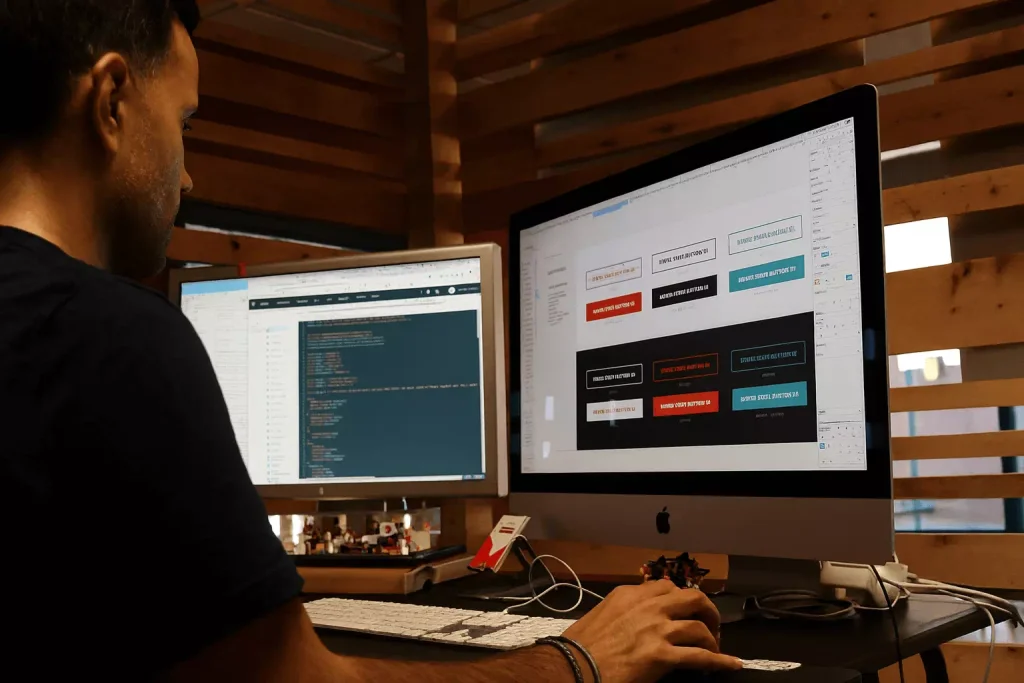Foundational Constructs in Interface Identity
Digital presence today must go beyond just functionality. It requires a layered architecture where every design element contributes to deeper engagement and longer session duration. A well-built interface does not simply organize components, it reflects intention and invites continued interaction. This visual and structural identity is what forms the backbone of user interface services that aim to hold audience attention.
An interface’s identity begins with spatial understanding. Positioning of icons, navigation bars, banners, and interactive zones must follow a hierarchy that feels intuitive without being overly predictable. The success of this layout is often determined in the first seconds of entry, making the opening visual an essential contributor to bounce rate reduction. The alignment of elements must lead the eye, simplify decisions, and keep users grounded in the flow of information.
Color theory, whitespace management, and typography choice all participate in defining the interface tone. These are not just aesthetic decisions but behavioral cues. Bright tones in action buttons, calming tones in informational backgrounds, and scalable fonts all serve the psychological aspect of UX design services. These micro-choices, repeated across all user journeys, form trust over time and shape perception.
For brands and service providers, this structured interface identity becomes a visual shorthand for quality. Without requiring heavy explanation, the layout itself signals professionalism and usability. This is especially crucial for platforms aiming to build long-term user relationships and recurring engagement.
Design Language as a Strategic Retention Asset
Retention begins at first impression but grows through recurring affirmation. This means that every layer of the interface, from introductory screens to secondary page interactions, must remain consistent yet dynamic. When users encounter a space that feels coherent, they are more likely to revisit it, return to its services, and rely on its content as a preferred source. This makes visual consistency a primary form of customer retention strategies.
Design language is not static. It evolves with interface updates, user feedback, and usage patterns. However, its core vocabulary must stay recognizable. Iconography, shadow logic, border curvature, and microanimations all work together to create a familiar environment. When applied with discipline, these small components act as engagement stabilizers.
Modern web design solutions incorporate adaptive design rules that allow interfaces to respond differently across devices while preserving visual tone. This device elasticity improves access and encourages repeated use on mobile, desktop, or tablet without user confusion. Whether through dropdown behavior or swipe gestures, each design movement is crafted to preserve mental flow and eliminate disruption.
When done well, design language can lead to higher satisfaction ratings and reduced learning curves. This reduces the friction commonly associated with onboarding and feature discovery. It shortens the journey from awareness to loyalty, proving that retention is more than functionality, it’s a byproduct of visual confidence and flow.
Functional Layering Within Component Systems

Interface construction thrives on modular thinking. Every segment, from header to footer, is composed of interlocking design systems that must operate independently yet harmoniously. A homepage might house hero images, live feeds, navigation tiles, and product cards all within a responsive framework. These zones must function without clashing, forming a cohesive grid guided by user behavior patterns.
Frontend optimization services focus intensely on these interaction regions. Hover states, button states, modal windows, and toggles are evaluated not just for looks but for clarity of purpose. When feedback is delayed or non-existent, users lose orientation. In contrast, responsive interaction fosters momentum and reduces drop-offs.
Hierarchy also defines component strength. High-priority features such as service listings or shopping cart access require bolder presence. Lower priority zones, like footer disclaimers or social media widgets, can be nested with subtlety. This layered structure, applied consistently, enables UI layout planning that anticipates user needs and reduces unnecessary clicking.
Accessibility features further enrich these component layers. High-contrast modes, scalable text, and keyboard navigation options expand usability across more audience types. These elements are not optional, they represent usability improvement services that respect inclusivity and boost overall satisfaction.
Ultimately, the sum of these functional layers contributes to both immediate usability and long-term interface memorability. Users stay not because they must, but because the interface feels like it understands them.
Emotional Guidance Through Interaction Flow

While data drives technical design, emotion drives user behavior. This is where interface customization options step in to fine-tune user paths and reactions. From color transitions to sound cues, every sensory prompt affects emotional state. Even the placement of microcopy, like tooltips or loading messages, can influence whether a user stays or leaves.
Modern interfaces use emotion to anchor utility. A checkout screen that feels reassuring and error-free builds trust. A dashboard that opens with encouraging visuals encourages exploration. Even error pages, when designed with empathy, prevent frustration from escalating into abandonment. These touchpoints function as invisible layers of support, creating invisible handrails for the user journey.
Each scroll, tap, or drag gesture must feel intentional and respected. Abrupt transitions or visual misalignments disrupt this emotional rhythm. Instead, seamless movements and gentle haptic cues foster comfort. Designers call this principle emotional flow, a state where users navigate without friction and feel validated throughout.
Conversion focused web design applies emotional mapping to increase the likelihood of goal completion. Whether subscribing, purchasing, or sharing, users must feel emotionally aligned with their choice. Interfaces that echo user intent, offer reinforcement, and reduce perceived risk can dramatically improve return metrics.
Digital experience platforms often use A/B testing to identify where emotional cues break or flourish. These insights shape future updates and reinforce the brand’s role not just as a tool but as a digital companion.
Infrastructure of Persistence and Repeat Interaction
The anatomy of an interface is ultimately measured by how often users return. Persistence isn’t about locking users in, it’s about inviting them back with clarity and value. This is where architecture intersects with engagement philosophy. Every design decision must serve the goal of repeat interaction.
Navigation logic plays a key role here. Menus must unfold with clarity, links must behave predictably, and calls to action must be distinct without being demanding. When navigation supports curiosity instead of enforcing it, users feel empowered to explore. The interface becomes a map rather than a maze.
Speed also matters. Platforms that lag or require multiple reloads damage confidence. Frontend optimization services resolve these bottlenecks by streamlining script calls, compressing assets, and deploying intelligent caching layers. The goal is not just fast entry but sustained interaction with minimal delay.
Personalization further enhances retention. Recognizing returning users with saved preferences, history tags, or suggested content creates a sense of belonging. These tailored views extend the life of each session and promote habitual usage. When interfaces recognize progress or continuity, users are more likely to see them as tools worth investing in.
Feedback loops add one final dimension. Whether it’s a subtle success message or a visible reward system, these responses form an internal narrative for the user. They tell the user: your actions here matter. That psychological reinforcement is the heartbeat of strong digital engagement.
Explore Retention Driven Design With Webdev200
Ready to build interfaces that inspire loyalty, increase conversions, and enhance every user session? Webdev200 specializes in designing digital platforms rooted in strategy, structure, and retention science. From UX architecture to frontend engineering, every layer is crafted to serve user expectations and business goals.
Whether launching a new product or revamping an existing platform, our team will help you develop UI systems that attract, engage, and retain. Reach out to us today and discover how interface design can become your most powerful retention strategy.

